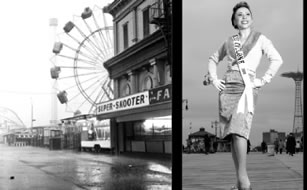By Casey Samulski
A piece of New York’s past is on display at the Puffin Room in Soho. But it’s questions of the future that haunt curator Carl Rosenstein. Opening this Saturday, the Puffin Room will be exhibiting “Coney Island Maybe,” a show of artwork and photos looking at the past, present and future of the fabled amusement park.
Coney Island has a special place in Rosenstein’s heart — he grew up in nearby Canarsie.
“I took every serious girlfriend I ever had on a date there,” he said with a smile.
At the Puffin Room, at 435 Broome St. just east of Broadway, artist names are displayed on authentic-looking Astroland tickets, so believable one will mistake them for the real thing.
Famous quotes on the wall by everyone from Henry Miller to Groucho Marx firmly plant Coney Island in the cultural consciousness of Americana. In one, Marx recalls his start in entertainment: “My first job was singing and sitting on a beer barrel at Coney Island for a nickel.”
It’s glimpses like these that reveal just what an icon the amusement park has become.
Charles Denson, director of the Coney Island History Project, whom Rosenstein has consulted with on the show, called the past contained within the amusement park “totally unique.” He said that’s what makes preserving the area so important. And while elements of the city’s proposed Coney Island redevelopment plan — like preserving the B&B Carousel and planned Steeplechase plaza — are a plus, he said reducing the special, C7 amusement-zoned area from 16 to 9 acres can’t come without a cost.
“It’s in a very vulnerable position right now,” Denson said. He thought City Council Speaker Christine Quinn calling this an “expansion” for amusements was misleading, and that the city had “lost the public’s trust.”
Denson’s largest concern, however, is the expansion of residential use in the area.
“To put these 27-story condos up is just unconscionable,” he declared. Denson talked about how he and others had fought in the 1960s and ’70s to ensure that there “would never be residential development south of Surf Ave. again.” He was dismayed with the city’s “lack of regard” for its own promise, and said that, at the very least, the size and impact of the proposed new buildings should be reduced.
It’s precisely these concerns that fired up Rosenstein to mount the exhibit. Touring the gallery with a visitor recently, Rosenstein called Coney Island an “irreplaceable treasure,” one which he claimed Mayor Bloomberg and others simply don’t understand. He called the city Economic Development Corporation’s proposed rendering of how the area might be redeveloped — posted on E.D.C.’s Web site — a “fraud.” He said the proposed revitalization of the amusement areas would never happen with developers busy scheming on how to capitalize on the location’s name recognition at the expense of its soul.
That’s why Rosenstein is opening the exhibit now. With poignant images like David Levine’s ominous “End of Joy,” depicting the derelict Thunderbolt rollercoaster — which sat unused from 1983 until 2000, when it was demolished — Rosenstein has managed to capture the sorrow that losing the rest of the park would mean for New Yorkers.
There are also lighter images, such as the work of notables like Reginald Marsh and Ralph Fasanella, depicting happy New Yorkers out for a day of escape from the city. Photo collages capture Hasidic Jews side by side with Williamsburg hipsters and Wall St. brokers having a day off. This sort of urban melting-pot experience, Rosenstein noted, is at the heart of New York City and part of what makes Coney Island so important.
Jasper Goldman, senior policy analyst at the Municipal Art Society, which Rosenstein also consulted on the exhibit, said it’s precisely events like what the Puffin Room is doing that are needed to get the word out about saving Coney Island.
The society’s goal is to engage the public and professionals in a dialogue about the amusement park’s future. It’s what Goldman called “a chance to create a real spectacle, to rebuild a 21st-century version of [the park].”
As he put it, the immediate goal is: “How do we engage the creativity and entrepreneurship of New Yorkers?”
M.A.S.’s Imagine Coney Web site invites interested citizens to do just that: plan for the amusement’s park’s future.
Rosenstein, for one, has already tapped one line of creativity.
“So many artists have been inspired by the joy and humanity of the place,” he noted as he looked fondly over the collection hanging on the Puffin Room’s walls.
The exhibit runs from Nov. 8 to Dec. 14. There will be several special events: On Sundays at 4 p.m., from Nov. 9 to Dec. 14, the Coney Island Oral History Project will present oral histories, and also record gallerygoers’ own Coney Island memories (free); on Sat., Nov. 22, at 8 p.m., Butoh Brothel and Ningyo will host Coney Island cabaret ($20); on Sat., Dec. 6, Coney Island U.S.A. Sideshow will present “freaks, wonders and human curiosities,” such as the Tattooed Lady, the Human Blockhead and Madame Electra ($20).



































